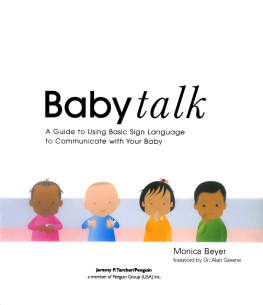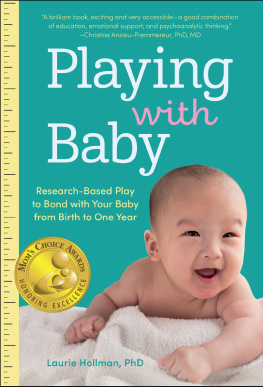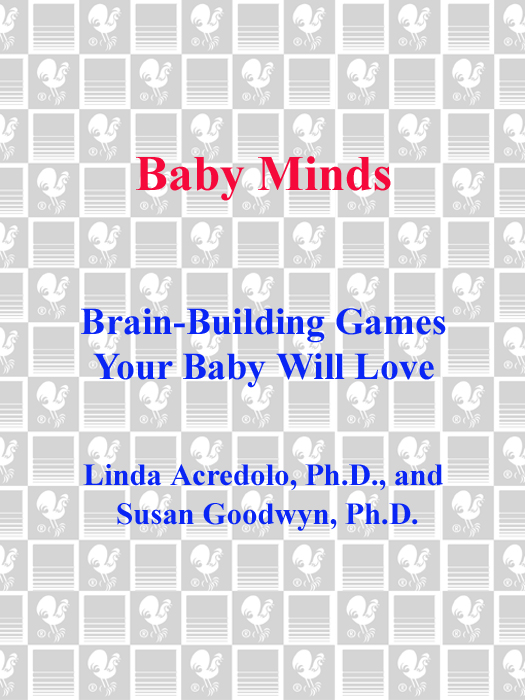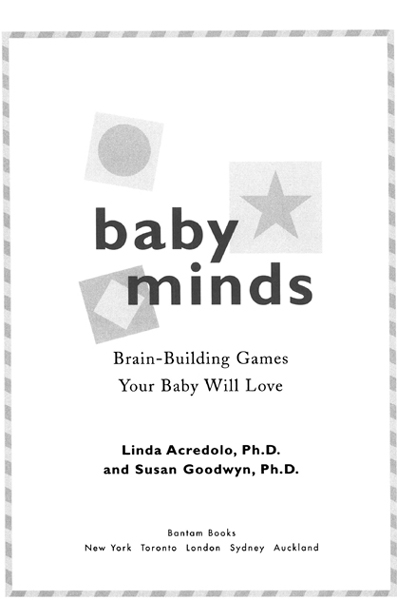Praise for Baby Minds
A timely follow-up to the authors first book, Baby Signs, which was so well received by both scholars and parents. Baby Minds deals with the concerns of all parents and provides sound and well-written ideas and suggestions concerning milestones in early development.
John Hagen, Executive Officer,
Society for Research in Child Development
This creative approach to early parent-child interactions is richly illustrated throughout with real-life examples. Baby Minds will help you catalyze your childs intellectual and emotional growth.
Bart Schmitt, M.D., Professor of Pediatrics, The Childrens Hospital of Denver
Fantastic! Baby Minds is an important resource for all caregivers of young children. Applying only half of the ideas in this book would insure the childs preparedness for success in school.
Kathryn Barnard, Ph.D., Department of Family and Child Nursing, University of Washington
In this engaging book, the authors take the most recent science on babies out of the lab and into the living room. Parents who read this book will appreciate their childs development in a whole new way.
Kathy Hirsh-Pasek, Ph.D., co-author of Baby Talk: The Magic and Mystery of Language in the First Three Years of Life
Excellent a wonderful resource for parents, pediatricians, childcare providers, and anyone working with young children.
Robin L. Hansen, M.D., Chief, Developmental-Behavioral Pediatrics, UC Davis School of Medicine
This useful book will help parents find that fragile but critical line between enriching their childs intelligence and pushing too hard.
Jane M. Healy, Ph.D., author of Your Childs Growing Mind and Failure to Connect
Praise for Baby Signs
This book provides a remarkably simple, intuitively pleasing, yet fascinating way to enhance communication, social interaction, and the sharing of inner worlds between parents and infants before they can talk.
Daniel N. Stern, M.D., author of Diary of a Baby: What Your Child Sees, Feels, and Experiences
This delightfully written book provides parents and caregivers alike a step-by-step approach to encouraging the use of Baby Signs. Theres more time for the kinds of positive interactions that are so important to a good parent-infant relationship.
Susan Crockenberg, Ph.D., Professor of Developmental Psychology, University of Vermont
Also by Linda Acredolo and Susan Goodwyn
B ABY S IGNS :
How to Talk with Your Baby
Before Your Baby Can Talk

BABY MINDS
A Bantam Book / July 2000
All rights reserved.
Copyright 2000 by Linda Acredolo, Ph.D., and Susan Goodwyn, Ph.D.
Illustrations copyright 2000 by Linda Acredolo, Ph.D. See for photo credits.
No part of this book may be reproduced or transmitted in any form or by any means, electronic or mechanical, including photocopying, recording, or by any information storage and retrieval system, without permission in writing from the publisher.
For information address: Bantam Books.
Library of Congress Cataloging-in-Publication Data
Acredolo, Linda P.
Baby minds : brain-building games your baby will love / Linda Acredolo and Susan Goodwyn.
p. cm.
eISBN: 978-0-307-80507-2
1. Play. 2. Games. 3. BrainGrowth. 4. Infant psychology. 5. InfantsDevelopment. 6. Child rearing. I. Goodwyn, Susan. II. Title.
BF720.P56 B33 2000
649.122dc21 99462164
Bantam Books are published by Bantam Books, a division of Random House, Inc. Its trademark, consisting of the words Bantam Books and the portrayal of a rooster, is Registered in U.S. Patent and Trademark Office and in other countries. Marca Registrada. Bantam Books, 1540 Broadway, New York, New York 10036.
v3.1
Dedicated with love to our mothers, Jean and Marjorie
Contents
Your Babys Amazing Brain
Whats Love Got to Do with It?
Figuring Out the World: Problem Solving
Memory 101: The Foundations of Learning
Baby Signs and First Words: Learning to Talk
Letters, Rhymes, and Love of Books: Preparing to Read
Counting Really Counts: Thinking About Numbers
Scribbles, Jokes, and Imaginary Friends: Fostering Creativity
Putting It All Together
Preface
W elcome to the amazing world of the human infant. The trip weve prepared for you is a fascinating one, complete with glimpses into facets of the infant mind whose existence few parentsor researchers, for that mattereven suspected until recently. But before the tour begins, wed like to take a few moments to introduce ourselves. So many aspects of our lives have contributed to this book that its hard to know where to begin. Certainly the fact that we have spent decades conducting carefully designed research of our own (culminating in our first book, Baby Signs) has made us appreciative of the ingenious research done by others. The discoveries made in developmental psychology laboratories around the world are more than just fascinating; they are also important for the guidance they provide parents and educators. What a shame if all this hard-won knowledge remained hidden in academic journals.
Our determination to make this information widely accessible is also a product of our many years in the classroom. Together we have taught literally thousands of college students. Many of these young people came to us already excited by the miracle of development and eager to learn more. Others were there for less lofty reasons. But no matter what their motivation at the beginning, we are proud to say that very few students ever left our courses without having had their eyes opened to the amazing inner world of childhood. We hope that Baby Minds will do the same for you.
Baby Minds is also a tribute to our own fascinating babies: Kate and Kai for Linda, David and Lisa for Susan. We have marveled, as every parent does, at the changes that seem to take place before our very eyes, the first three years passing so quickly that they sometimes seem like a dream rather than a reality. Our children are now well beyond early childhood, but the lessons we learned from them (and the new lessons Susan is learning with her two grandchildren, Brandon and Leannie) remain in our memories. These have provided some of our favorite examples of baby minds.
Finally, Baby Minds is the work of two best friends. Susan first came to the University of California at Davis in 1980 to begin her graduate work. Linda had arrived only a couple of years earlier as a new assistant professor. Within a few weeks of our first meeting, we developed a level of friendship and camaraderie that we never take for granted, even as Susan moved on to become a professor herself. We still work hard on research projects and writing, but we also laugh a lotand its the laughter that we treasure the most.
Now that you know a bit more about your guides, fasten your seat beltsyour tour is about to begin.









